For some gamblers, sweet-talking a slot machine seems like a good idea with every pull of the lever or push of the button; however, it might not make much difference. Delfabbro and Winefield (2000) hypothesized that irrational gambling cognitions would be related to the level of reinforcement (i.e., the total amount won during a gambling session) and risk taking (i.e., the mean amount staked on each outcome) in a study of slot machine players (n=20).
Sitting at standard slot machines outfitted with a miniature video recorder and a powerful microphone, participants were asked to play the slots as they normally would, with assurance from the researchers that any money won was theirs to keep upon completion of the experiment. Participants were asked only to verbalize any and all occurring thoughts while playing for fifteen minutes. They also were prompted to speak only if thirty seconds between verbal expressions had elapsed.
Delfabbro and Winefield transcribed and analyzed the verbalizations they collected, classifying them as irrational, rational, or other. They considered irrational statements to be those that reflected participants’ attempts to influence the outcome of the game inappropriately. They classified rational statements as those that accurately assessed game strategy, odds, and a player’s ability to control the game. Finally, "other" statements consisted of descriptive phrases that related to game outcome (Delfabbro & Winefield, 2000). While the data are not totally representative of the volume of speech documented, (some verbalizations were extremely lengthy while others were only a few words), they revealed that 14% of the total statements collected were irrational (Delfabbro & Winefield, 2000). However, when these irrational statements were analyzed against game-related and strategic verbalizations, the level of irrationality climbed to 75%, suggesting that irrational thoughts are common to game-related cognitions.
Delfabbro and Winefield then divided the subjects into two groups based upon their median return. Group 1 obtained a greater return than the median and Group 2 a lesser return than the median. No significant difference was found with regard to the percentage of total irrational verbalizations between these groups (Delfabbro & Winefield, 2000). However, when these groups were aggregated and then re-split into two new groups, a high-risk group and a low risk group (based on the median amount wagered per slot turn), there was a significant difference between them. A comparison of these groups revealed that the high-risk group was more irrational than the low-risk group (t=2.11, df=19, p<.05). Hence, irrationality was found to be unrelated to slot machine success, but meaningfully correlated to risk-taking patterns (Delfabbro & Winefield, 2000).
While the results of this research show an important relationship among gambling cognitions, irrationality, and risk-taking, the research is preliminary and exploratory. The sample size is small and potentially not representative of typical slot machine gamblers. The data is highly variable. This variability might reflect verbalizations by some study participants that were not completely accurate, potentially one influence that increased the observed variability. This circumstance is possible because the researchers reminded participants whose verbalizations waned throughout their slot play to articulate their thoughts. Verbal responses to these requests likely reflect the impact of the research demands on participants’ desire to follow directions rather than authentic representations of cognitive thoughts during slot machine play. In this same regard, it remains unclear whether verbalizations mediated behavior or simply were justifications for behavior (e.g., "I have an idea that. . .", or "What I usually do here. . ."). In addition, these expressions might have been a description of what was happening during the game at a specific moment in time ("I don’t seem to be winning very much. . ." or "This machine is no good."). Behavior justifications presumably would be representative of normal behavior rather than descriptions verbalized to satisfy the researchers requests.
Despite these limitations, the results of this study warrant further attention. With few notable exceptions (e.g., Bujod, LaDouceur, Sylvain, & Boisvert, 1994; Ladouceur & Walker, 1998; Ladouceur, Paquet, & Dube 1996; Sylvain, Ladouceur & Boisvert, 1997), research on the connection between gambling and specific cognitive processes common to gaming activities is an understudied area. In addition, mediating cognitive processes must be examined to better understand how these processes influence problem and pathological gambling patterns. An improved understanding of the mental dynamics associated with both normal and disordered gambling holds important potential to inform the development of additional and more effective treatment strategies.
References
Bujod, A., LaDouceur, R., Sylvain, C., & Boisvert, J. M. (1994). Treatment of pathological gamblers: an experimental study. Journal of Behavior Therapy & Experimental Psychiatry, 25(4), 275-282.
Delfabbro, P.H. & Winefield, A. H. (2000). Predictors of irrational thinking in regular slot machine gamblers. The Journal of Psychology, 134, 117-128.
Ladouceur, R., & Walker, M. (1998). The cognitive approach to understanding and treating pathological gambling. In A. S. Bellack & M. Hersen (Eds.), Comprehensive Clinical Psychology (pp. 588-601). New York: Pergamon.
Ladouceur, R., Paquet, C., & Dube, D. (1996). Erroneous perceptions in generating sequences of random events. Journal of Applied Social Psychology, 26(24), 2157-2166.
Sylvain, C., Ladouceur, R., & Boisvert, J.-M. (1997). Cognitive and behavioral treatment of pathological gambling: A controlled study. Journal of Consulting & Clinical Psychology, 65(5), 727-732.





